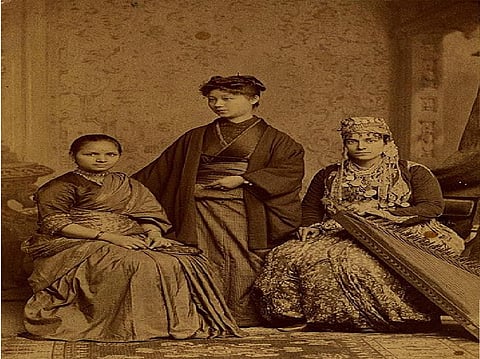
- Home
- न्यूजग्राम
- India
- World
- Politics
- Entertainment
- Culture
- Lifestyle
- Economy
- Sports
- Sp. Coverage
- Misc.
- NewsGram Exclusive
- Jobs / Internships

New Delhi, August 15, 2017:
There is a remarkable archaic picture of some extraordinary medical students in Pennsylvania in 1885, who was featured on Public Radio International's "The World" and has been making rounds on the web.
The picture shows a group of medical students, all women, dressed in their traditional attires belonging from India, Syria, and Japan.
What's so outlandish about the image that has stunned the internet? Nothing is too remarkable in the picture until you see the period of time indicating the image from the year 1885. Each woman was the first in their respective countries to obtain a degree in western medicine.
Why did these women trek to the United States for studies?
America was the only place in the world at that time who offered Medical education to women. It's also a tribute to the Quakers of Pennsylvania, who believed in women's rights sufficiently to set up the WMCP way back in 1850 in Germantown.
Photograph of Anandi Gopal Joshi (March 31, 1865 – February 26, 1887). Wikimedia Commons
One of the strong-minded looking women among the group is Anandibai Joshi from India. She was married off at the age of 9 to a high caste Brahmin family. Her husband motivated her to pursue her studies back then, which is commendable to acknowledge with regard to the antiquated time of the history. But what impelled her to become a doctor was the tragic story of her own. At the 14, she gave birth to a child who died right after ten days post birth due to unavailability of healthcare facilities. From that point onwards, she decided to become a doctor and overcome hurdles that came her way.
[bctt tweet="Anandibai Joshi was the first Hindu woman to set foot in America." username="NewsGramdotcom"]
Hindus of ancient India considered traveling overseas as a sin that would corrupt them, regardless of which Anandibai succeeded in attaining her dreams. She was the first Hindu woman to set foot in America.
The WMCP received a letter of congratulations from Britain's Queen Victoria, who was also Empress of India on the graduation of Anandibai.
The Pri.org mentioned an extract from her letter of application to WMCP:
"[The] determination which has brought me to your country against the combined opposition of my friends and caste ought to go a long way towards helping me to carry out the purpose for which I came, i.e. is to to render to my poor suffering country women the true medical aid they so sadly stand in need of and which they would rather die than accept at the hands of a male physician. The voice of humanity is with me and I must not fail. My soul is moved to help the many who cannot help themselves."
The picture is also a reminder of just how exceptional America was in the 19th century. America was the inspirational beacon of freedom and equality for the entire world back then.
Another woman from Japan, Keiko Okami, returned to Tokyo and was recognized as a doctor and appointed as the head of gynecology at one of the main hospitals. However, she resigned a couple of years later when the Emperor forbade to receive her during a visit to the hospital because she was a woman.
Sabat Islambouli from Syria also headed back to Damascus and later moved to Egypt in 1919 according to the alumnae list of that year. It is not known what happened to her ultimately as the college lost contact with her.
Joshi was respectfully appointed to a position as physician-in-charge of the female ward at the hospital in the princely state of Kolhapur. At the age of 21, she was afflicted with tuberculosis and died within the year.
Anandibai is still revered not lesser than a hero among Indian feminists
Again breaking away with custom, Joshi's husband sent her burial remains to one of her American friends, who laid them to rest in Poughkeepsie, New York.
Besides the international students, the college also produced the nation's first Native American woman doctor, Susan LeFlesche. Many American graduates traveled overseas as medical missionaries, particularly to China, Korea, India and elsewhere.
It's living alumnae number about a 1,000, and are found in almost every part of the American republic and in many foreign countries namely, Egypt, India, China, Japan, Persia, and Korea.
As the heterogeneity has waxed and waned throughout the years, it is interesting to perceive that it was still strong at a time when it was not a popular stance. Even in the crisis of the Second World War, WMC admitted students from Japanese internment camps. However, not everyone was happy about their presence.
